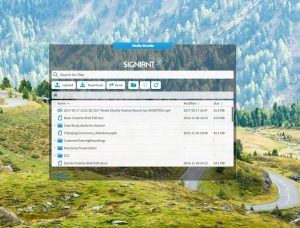SVG Europe Sit-Down: Signiant’s Greg Hoskin on cloud technology end-user education and the future of cyber security

Greg Hoskin, Managing Director – EMEA/APAC, Signiant
Signiant’s intelligent file movement software helps content creators and distributors ensure fast, secure delivery of large files over public and private networks. Built on Signiant’s award-winning patented technology, the company’s on-premises software and SaaS solutions readily move petabytes of high-value data every day between users, applications and systems. Greg Hoskin, Managing Director – EMEA/APAC, starts our conversation with a look back to last October…
Your blog stated that 1 October 2017 was a landmark day. Can you explain why this day was so important in the file transfer market?
1 October 2017 was the day that members of the Digital Production Partnership (DPP) – the industry organisation driving the move to fully digital content creation and distribution – stopped accepting delivery of programmes on videotape. Since the DPP counts all of the UK’s major broadcasters as members, including BBC, ITV, Channel 4, BT Sport, 5 and Sky, this was a real watershed moment in the transition to files as the primary medium for moving video content across the Media and Entertainment supply chain.
Have users really come to understand what we mean by ‘The Cloud’?
‘The Cloud’ is no longer this new, nebulous thing that means one thing to one person and something else to another. Users generally do understand what it is and what the benefits are. However, there are still some nuances that get lost, and some persistent misconceptions. For example, not everyone yet understands the difference between a “cloud-enabled” – or “cloud-washed” – solution, in which on-premises software is simply ported to virtual machines in the cloud, and a true “cloud-native” service. Similarly, there is a common misconception that using a cloud service automatically means the content has to reside in the cloud – it doesn’t necessarily. And then there is still a tendency to be nervous about security with the cloud, when numerous studies have indicated that the big cloud platforms can be at least as secure as many businesses’ own data centres. Cloud adoption is not without its challenges, nor always the right answer for every aspect of a user’s needs, but it is real and growing.
Following on from that, how are you educating customers with regards to this technology?
For us the key is recognition that “to cloud or not to cloud” is rarely the right question. It’s better to ask what a customer is trying to do, and then find the solution that best matches the need. One of the best ways is to show them how other customers are benefiting from cloud technology. We have many customer success stories demonstrating how organisations of all shapes and sizes, including most of the world’s top media and entertainment companies, use our cloud-native file transfer solutions. And because our technology is used as the on-ramp for lots of cloud-based media workflows, we can offer insight into how various public cloud services are being used across the industry. Our website is full of videos, articles and blogs that will help customers to recognise their current situation and find out how they can improve their services for their own clients – and their bottom line. And, of course, we attend as many industry events as we can around the world, as nothing beats a face-to-face conversation about a customer’s unique challenges and requirements.
Cyber security is of concern to all users. What are you doing to ensure the integrity of users’ data?
Security is something we take very seriously at Signiant and is built into all of our products – on-premises or SaaS – from the beginning of the design process. Managing data security demands a high level of expertise, regardless of whether data is processed on-premises or in the cloud.
We follow the “defence in depth” secure design principle which advocates implementing multiple layers of protection around assets. The word “layer” is important because it conveys that an attacker must break through each “layer” in succession in order to successfully compromise an asset. Building on the core Transport Layer Security (TLS) built into the Signiant transfer protocol, all of our products incorporate several security controls for a system so that multiple security failures must occur before an attacker can gain access to critical resources.
Looking, for example, at Media Shuttle, our cloud-native SaaS solution for person initiated file transfers, we have security in multiple layers, full customer control over storage, secure encrypted cloud communications, end-user storage visibility and access
Security is critical for our customers, many of whom are moving highly valuable, business-critical, content. We regularly have our solutions audited by independent third-party security experts to check that we are providing the level of security our customers expect and require.
You have mentioned the ‘Horror Stories’ associated with File Transfer. What are some of these ‘stories’?

Media Shuttle, is Signiant’s cloud-native SaaS solution for person initiated file transfers
I’m glad to see you are reading our blog! It was really just a fun Halloween post…. However, there are potential ‘horrors’ out there that put your content, your money or your time at risk.
Look at FTP, for example. Although it has evolved over time, it’s still slow, difficult to manage and requires a lot of maintenance.
Then there’s security. If you’re using an unsecure file transfer tool, like some of the consumer-grade online file sharing services, your video files are at risk of being stolen and leaked on the Internet.
Shipping physical hard drives or LTO tapes still happens too, but time-crunched production schedules suffer, to say nothing of critical content getting lost or damaged en route. It’s far faster – and safer – to send files via a secure accelerated file transfer tool, and it won’t stop for pizza on the way.
Do you have a European sports projects you can share with us?
Signiant solutions are deployed at most of the world’s major sporting events, including ones that take place in Europe. While we are unable to name all of our sports customers, some we can name with a European base or focus include: Formula One, Manchester City and Liverpool Football Clubs, World Rugby Limited, and the French Tennis Federation. Our solutions are also used by European sportscasters such as BBC Sports, and major US sportscasters covering European events such as ESPN, NBC Sports and CBS Sports, as well as by sports production specialists such as Wige Media AG in Germany – recently rebranded as Sporttotal AG.
How do you see the future of the file transfer market progressing?
Three things we know for sure are that first, files are getting larger, secondly, people are demanding ever more content, and thirdly, everyone wants content delivered quicker. So it’s a great time to be in the accelerated file transfer business!
But more than this, customers are looking for easy to use and maintain, fast to deploy, flexible, and scalable solutions, and ones that are priced based more on usage than on the more traditional permanent licensing model. So cloud-based solutions are a natural fit in today’s environment.
And in the sports arena, we are definitely seeing a trend towards minimising the costs associated with building out a major presence at remote events, and a move more towards leaving as much as possible at home. This trend inherently suggests a greater need for fast file transfers to get content back to the people who need to produce the quick turnaround elements of an event’s coverage.
